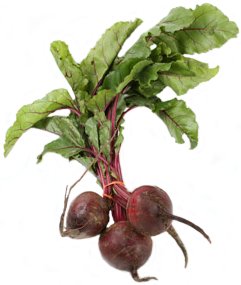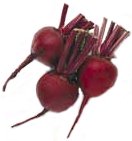

Beetroot

Beetroot (table beet, red beet). Beta vulgaris subspecies rubra. Chenopodiaceae. A biennial grown as an annual for its fleshy red ‘root’, the hypocotyl. The shoot consists of a rosette of dark red or green ovate leaves. The red colour is betacyanin, a nitrogen-containing compound with chemical properties similar to the anthocyanins. Beetroot is indigenous to Southern Europe and Asia and was probably derived from wild sea beet (Beta vulgaris subspecies maritima). Its cultivation is now widespread in both temperate and tropical regions. The crop grows best in cool regions where optimum mean temperatures are 16-18ºC. Temperatures above 25ºC may adversely affect growth and produce distinct zonal markings within the roots. Beetroot is fairly hardy and can withstand moderate frost but will bolt and run to seed following prolonged exposure to temperatures below 10ºC. Roots may be harvested during the summer and autumn and a winter supply can be obtained from plants remaining in the soil, or from cold storage. Mature roots harvested during the autumn may be stored whole in clamps or boxes of soil or peat in a cool but frost-free place. Beetroot can be grown successfully on a whole range of fertile well-cultivated soils but light soils are the best for good root formation. Soil texture may be improved by the incorporation of well-rotted manure or compost, but roots are likely to become misshapen and forked if fresh manure is used. Soil pH should be 6.0-6.8 and, if more acid, should be raised by liming. This site should be well cultivated during the autumn and broken down to a fine tilth for seed sowing in the spring. The crop is not readily transplanted, but early sowings can be made under cloches or plastic film. A continuing supply of young roots can be produced from successional sowings during the spring. Early sowings should be of the early globe cultivars but a late main crop of long-rooted beets can be sown during early summer. Plant population can be adjusted to control root size, although yields of beetroots are severly depressed at high densities. Even where small roots are required for pickling, planting densities should not exceed 215 per square metre. For Early crops, 55 plants per square metre in 18cm rows with 10cm between plants within rows, would be appropriate, but for the longer-term main crop approximately 110-160 plants/m² would provide the maximum yield of medium-sized roots. These populations are achieved from 8-10cm square planting, although in practice it is easier to arrange plants in, for example, 20cm rows with plants spaced at between 3-5cm within the rows. It is important to keep beetroot well watered throughout growth since moisture stress will cause roots to become woody and inedible.
Beet ‘seed’ consists of the dried flowerhead which normally contains two or three seeds and is called a cluster. A cluster may therefore produce up to three seedlings, which will then require thinning. Monogerm varieties such as ‘Monodet’, ‘Monogram’ and ‘Monopoly’ (rough-skinned), and ythe conical ‘Cheltenham Mono’, produce a single seed per cluster, thus reducing the need for later thinning. A futher development in beetroot cultivars is that of resistance to bolting following exposure to low temperatures. This is an important consideration for early sowings, when bolting-resistant cultivars should be selected. For summer and autumn production, when the risk of bolting has passed, other types may be used. Cultivars are also divided into round and long on the basis of root shape. Most beetroot cultivars are globe-shaped. ‘Boltardy’ and ‘Regala’ are bolt-resistant and specially suited for early sowing. ‘Little Egypt’, ‘Red Ace’, ‘Replaten’ and ‘Early Red Ball’ are notable for rapid maturing from sowing. ‘Ruby Queen’, ‘Detroit Dark Red’, ‘Green Top Bunching’, ‘ Vermillion’ and yellow fleshed ‘Burpee’s Golden’ are maincrop varieties. ‘Little Mini Ball’ is a miniature, valuable for pickling, and ‘Cylindra’ and ‘Forono’ are elongated forms producing uniform slices. Long-rooted types like ‘Cheltenham Green Top’ and ‘Lutz Green Leaf’ are suitable for storing and sown relatively late. ‘Chiogga’ is the candy-cane beet with white flesh and pink concentric rings. Principal pests are mangold fly and swift moth caterpillars. Diseases include crown gall, damping-off, leaf spot, scab downy mildew, rust and violet root rot. Virus diseases are of considerable importance in sugar beet; the outbreak of rhizomania disease in the UK constitutes a threat to production and eradication campaigns may have implications for local gardeners in sugarbeet-growing areas. Mineral deficiency of boron, magnesium and manganese may also occur.
|
Home
Grow Nuts
Grow Herbs
Grow Fruit
Cyberian Index
If you like this website and want one of your own contact
Cyberian All information correct at
time of publication and open to updates as necessary. No part of this website,
or its vectors, may be produced in any shape or form, using any type or design
of medium, system, equipment or otherwise without the prior written consensual
notice of the Cyberian. Any breach of these requirements will result in the
appropriate action. If in doubt, e-mail contact is recommended.
Some components of this website were obtained as open-source software and are
used in the same non-profit manner on this website.